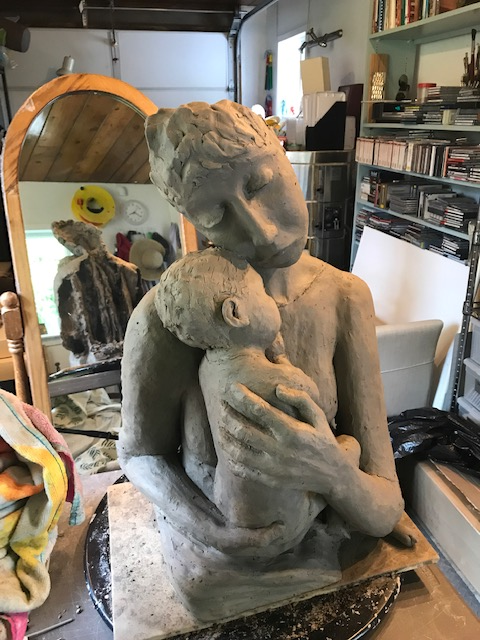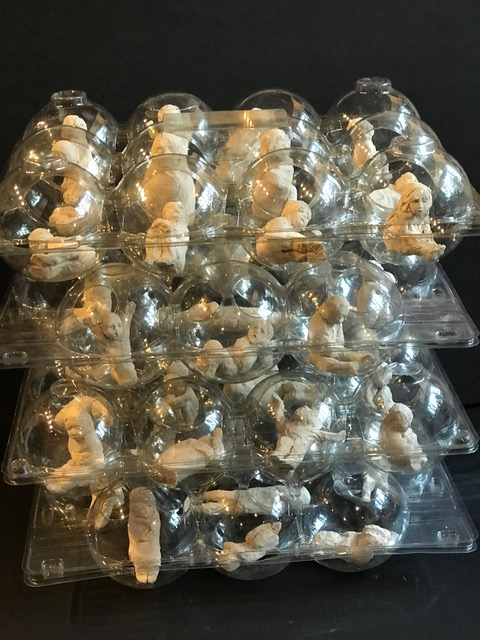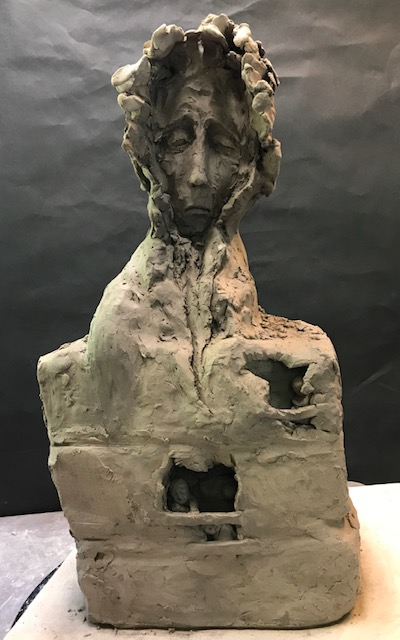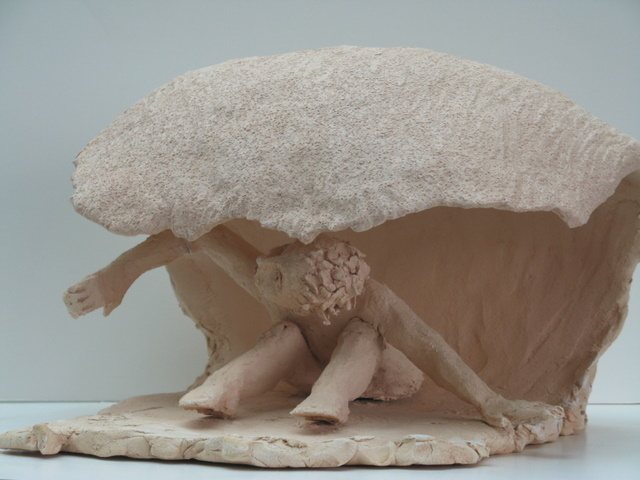By Alec Clayton
Irene Osborn’s sculptures shine a blinding light on what it means to be human, on the tragedy, the triumph, the sadness, and the hope of humans. In her overall oeuvre, sadness, anger and outrage outnumber joy.
Osborn celebrates and honors the naturalness of her media, clay — its slab-like, pliable warmth. She never applies colored glazes but rather allows her pieces to stand as raw surface. And she recognizes the importance of sculpture’s three-dimensionality, understanding that sculpture should be visually arresting from all sides. More often than not, when viewers step from the front to the back of one of her pieces, they are faced with something unexpected. Like holes gouged into the figure and other figures inside, hidden perhaps, cowering in the sheltering cave of the parent figure.

Osborn’s ceramic sculpture “She Thought They Would Be Safe Once They Crossed the Border” shows us a refugee cradling a baby in her arms. Roughly sculpted in chalky white clay, it depicts a screaming woman with arms and hands torn, jagged shards at shoulder and wrist, one unattached hand clutching the infant to her breast. The figure is hollowed out. The woman’s back opens into a deep cave, and inside the cave is another figure of a mother holding a child.
A similar figure depicts a woman holding an infant to her breast and is similarly hollowed out. But this one, rather than being anguished, is sweet and loving.
Osborn’s “Chemotherapy” is a chalky white clay sculpture of the bust of a bald-headed woman with haunting black holes for eye sockets.
Yet another nursing mother is placed in a bathroom stall. The slab clay walls of the stall close in on her as if it is a kind of prison; she is forced to hide in order to do such a natural thing as nursing her baby.
These sculptures are emotionally laden. “Reminiscent of the heroic paintings of Gericault,” says fellow artist Susan Christian. Another local artist, Gail Ramsey Wharton, says, “It’s not a stretch for me to compare the sobering and compassionate beauty of Irene Osborn’s work to Anselm Kiefer. Many of her provocative works, like his, have been permanently etched into my brain: immigrant children curled into stacked containers, or standing alone in court, a mother nursing her baby in a bathroom stall.” She continues, “The range of her expression is so vast, and her willingness and ability to confront our raw human condition with such heightened moral conscience, is truly awe-inspiring. I’m really humbled by Irene’s work and the purpose and meaning she puts into every piece.”

The children curled into stacked containers is a piece named “Commercialization of Children in Detention” — four stacked plastic containers with a dozen molded bubbles each and a sculpted infant in each bubble. Osborn explains: “I was born in 1945, less than one month after my hometown had been bombed and 90 percent destroyed. My mother took my three siblings to the river when the bombs started to make sure we would have enough oxygen to survive. Both my parents had been anti Nazis but that did not matter, the bombs did not ask ‘Are you guilty of the atrocities committed in your name?’ It was enough that you lived in Germany to make you an enemy that could be killed. The logic of war.
“Because of this background, the wars and resulting refugee crises and the treatment of people applying for immigration resonated deeply with me. I tried to find a way to address this in my work. These refugees are just responding to the hardships brought on by global warming and war. I try to capture their humanity. The separation of families, children, at the U.S. border added to the misery inflicted upon these unfortunate people. By putting the children, isolated from each other, into commercial containers, I tried to highlight that this immigration policy is highly profitable for the private companies that run these detention centers. $740 per day per detainee, that adds up fast.
“Normally, I start with a face, then decide where it will take me. This series, I started with the need to make a compelling point about refugees and the way they are portrayed, perceived, and treated.”

Osborn was born in Würzburg, Germany in April 1945. Her parents were pacifists and art historians. “I remember the lively discussions about the latest works and how the Nazis had set back the recognition of modern art in Germany,” Osborn recalls. “None of my friends had abstract art in their home. My father taught at the university, was an expert on Rubens, but his passion was modern art. He lectured on both.”
Moving to Canada in 1967, Osborn began work as a research laboratory technician and took collage classes in Halifax, Nova Scotia. She then moved to New York City. “Again, I worked in a research laboratory. I lived within walking distance from the Metropolitan Museum. Luckily, there was no entrance fee, donations were encouraged. The Frick Gallery was another magical place with no entrance free.”
In 1974 Osborn moved back to Halifax and in ’77 to Charleston, S.C. “This was a real culture shock. It is a beautiful city, but it seemed that they were still fighting the Civil War. When there was talk about the war, they meant the War of Northern Aggression. I, a German, was more welcome than any person coming from north of the Mason-Dixon line.”
Osborn came to Olympia in 1984. Not long after moving to Olympia, she was diagnosed with cancer and a 10 percent chance of survival. “I had to reevaluate and focus on what was really important.” Her eldest daughter encouraged her to take classes at The Evergreen State College, where she studied Art History with Professor Ann Story and studied life drawing, watercolors and printmaking. She studied clay with Joann Gaither at the Olympia Center and sculpture at Evergreen with Mike Moran.

Osborn says of her work now, “My sole concern when I work is to catch what I want to express so that I am satisfied with the result. I naturally hope that others see what I try to do but my goal is to make my sculptures speak for themselves so that no explanation is necessary. I am surprised and pleased when others see something else in my work that I had not intended.
“Most of my early work is based on the belief that others have had similar personal experiences or observations than I have had, and people can recognize the emotion I try to convey.”
Artist Becky Knold says, “Irene is a survivor (cancer, divorce, immigration from both post WW2 Germany and Canada) who offers cheerful support, good humor, and genuine friendship. Her spirit of positivity in light of a deep recognition of life’s tragedies and unfairness is indomitable. This is what makes her art so powerful: it comes from a place of empathy, authenticity, and deep caring about the pain and injustices that have been part of not only her own personal life, but are also so blatantly part of our contemporary social conditions.
“When she sculpts a mother and child fleeing from destruction, she is showing us the plight of all who seek refuge. When she sculpts a broken individual (from abuse, addiction, incarceration, separation, violence, war) she brings us face-to-face with painful realities that we all know. From such honesty, and from the facts of her own life, she gives testament to the possibility for survival of the human spirit.”


I really like your work!
An extraordinary artist. The emotion slices away any pretense of denial of human barbaric and cruel behavior against each other. The impact of these sculptures are transformative. Thank you Irene.